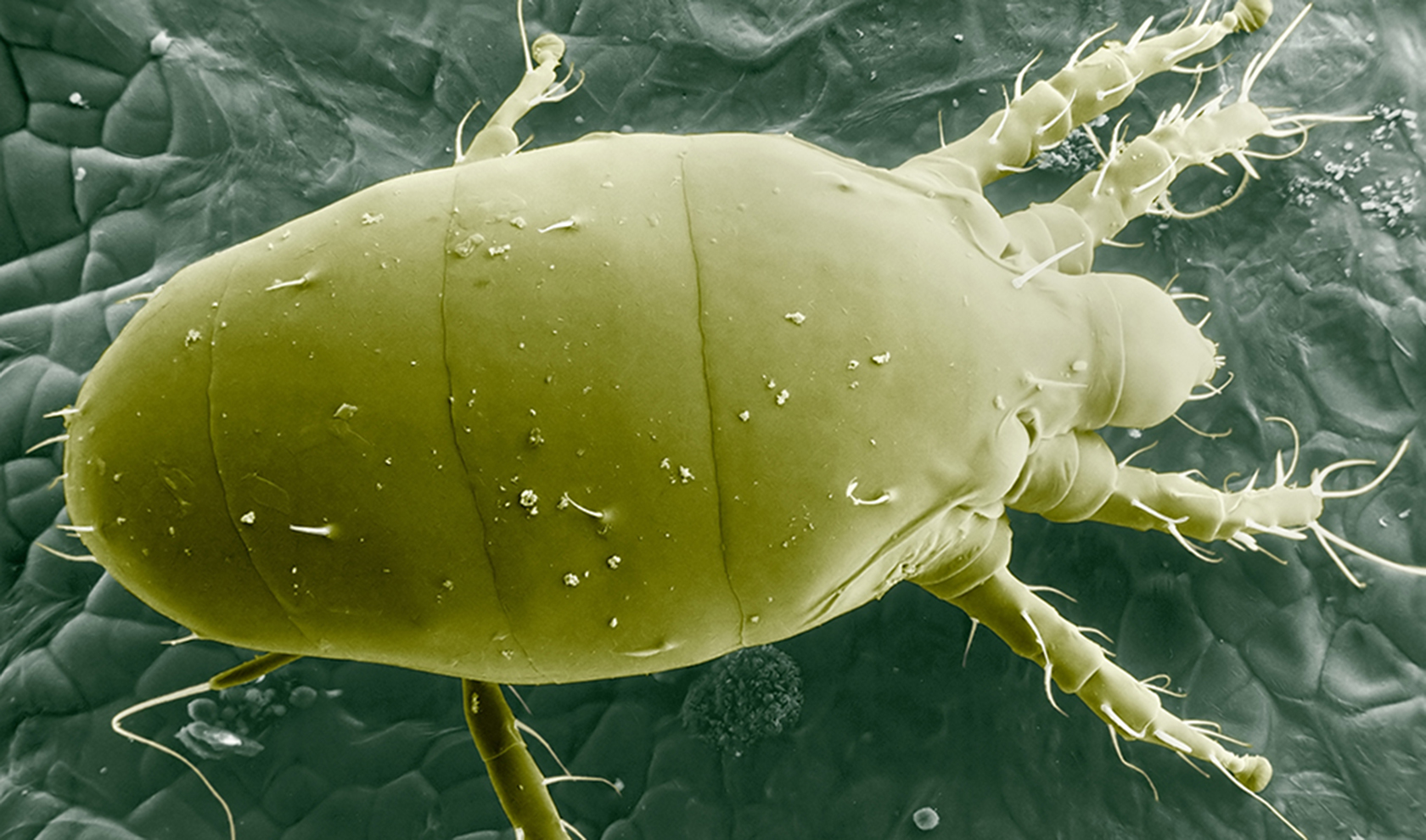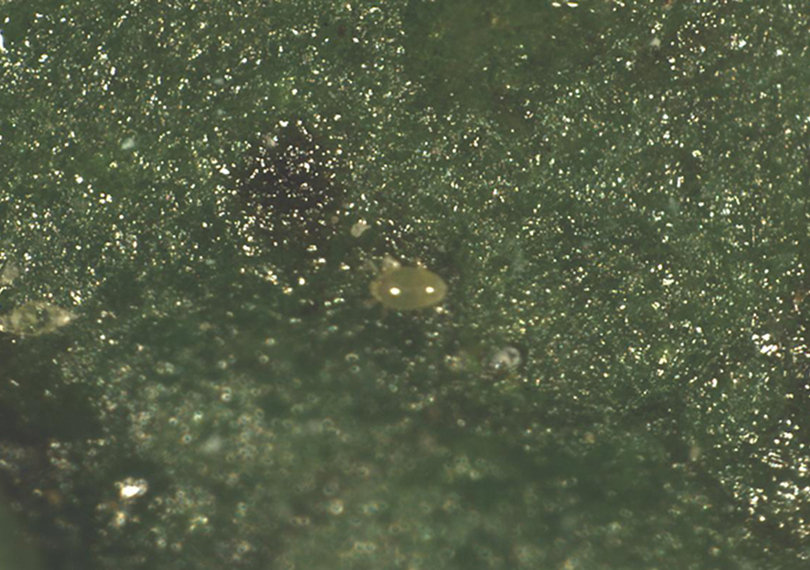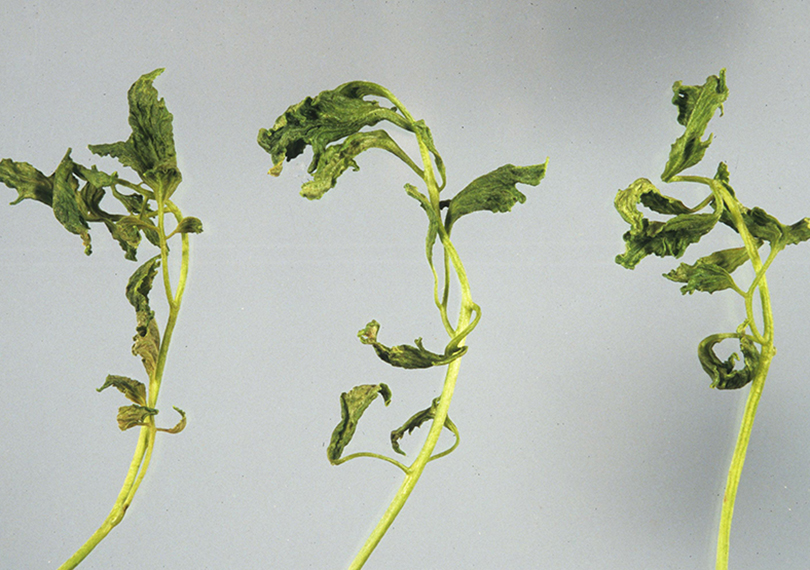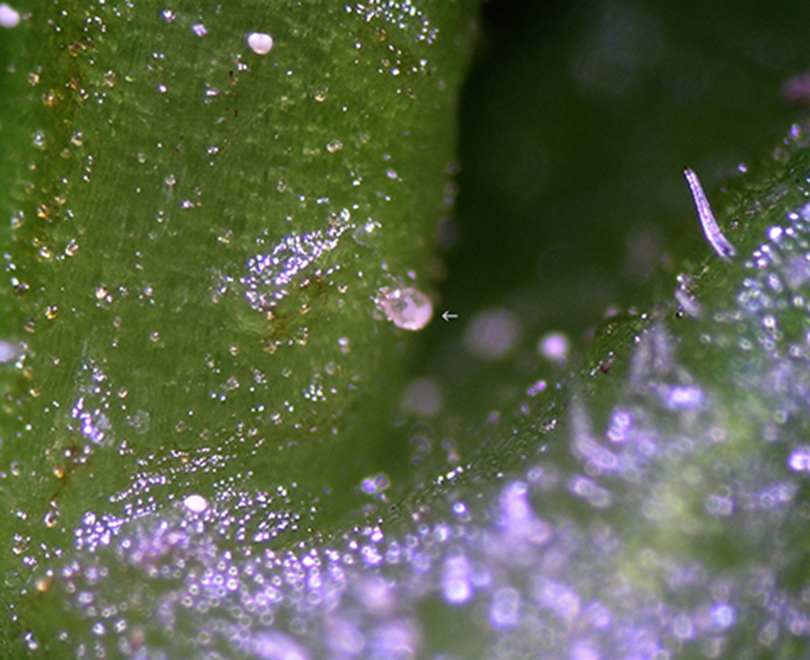Broad Mite
Polyphagotarsonemus latus
Hosts
- Hemp
- Many fruits, vegetables, and ornamentals
Description
Broad mites are extremely small mites, only capable of being seen with a 10x hand lens or greater. Adults are oval and round in shape and light yellow to green in coloration. Females can be differentiated from males due to a stripe that crosses the back of the body which males do not have. Males are also smaller and faster than females.
Life Cycle
Egg | Larva | Nymph | Adult
- Many generations per season.
- Females lay eggs on the undersides of foliage.
- Unlikely to be capable of overwintering outdoors in Utah but can overwinter indoors on host plants.
Damaging Lifestage(s): Larva, Nymph, Adult
Damage Symptoms
Broad mite feeding can cause malformation of leaves and flower buds that take on a warped and hardened appearance. Feeding can also cause a bronzing effect on leaf color. Plant growth can be stunted and even aborted if feeding happens early enough in the host plant’s life.
Time for Concern
It is unlikely that broad mites are present in Utah because these arthropods prefer high humidity and low temperatures, but they may occur inside greenhouses. Spring is the likely time of concern for this pest.
When and Where to Scout
- Starting early spring, search for damage symptoms (in greenhouses).
- Broad mites prefer shaded areas of host plants.
- Use a 10x hand lens to search leaf surfaces and crevices.
Threat Level
Low.
Occurrence in Utah
Not yet detected in Utah.
Management
- Apply horticultural oil or insecticidal soap to mites.
- Maintain beneficial arthropods.
When to Consider Treatment
If symptoms are severe and causing economic damage.
Look-alikes
Other mite species.
Insecticides for Mites
| Utah-Registered Product | Active Ingredient(s) | Notes |
|---|---|---|
| Bonide Insecticidal Soap MultiPurpose Insect Control Ready To Use | potassium laurate | Greenhouse use only. |
| Brandt Ecotec Plus | rosemary oil | Greenhouse use only. |
| Captiva | capsicum oleoresin extract | |
| Captiva Prime | capsicum oleoresin extract | |
| Dr. Earth Final Stop OMRI Fruit Tree Insect Killer (RTU); Concentrate | rosemary oil | Outdoor use only. |
| Dr. Earth Final Stop OMRI Rose and Flower Insect Killer (RTU) | rosemary oil | Ground application only to non blooming plants. |
| Dr. Earth Final Stop OMRI Vegetable Garden Insect Killer (RTU); Conc. | rosemary oil | Before flowering only. |
| Dr. Earth Final Stop OMRI Yard and Garden Insect Killer (RTU); Conc. | rosemary oil | |
| Dr. Earth Final Stop ProActive Yard & Garden Insect Killer (spray) | rosemary oil | |
| EcoWorks EC | neem oil, cold pressed | |
| Garden Safe Brand Insecticidal Soap Insect Killer | potassium laurate | |
| Kopa Insecticidal Soap | potassiums salts of fatty acid | |
| Leaf Life Gavicide Green 415 | mineral oil | Greenhouse use only. |
| Mammoth Cancontrol | thyme oil | |
| Mite-E-Oil | mineral oil | Greenhouse use only. |
| M-Pede Insecticide Miticide Fungicide | potassium laurate | |
| Natural Guard Brand by Ferti-lome Insecticidal Soap Concentrate | potassium salts of fatty acids | |
| Omni Supreme Spray | mineral oil | |
| Organocide 3-in-1 Garden Spray Concentrate, Ready to Spray; Ready to Use | sesame oil | |
| Organocide Bee Safe 3-in-1 Garden Spray Concentrate; RTU | sesame oil | |
| Ortho Tree & Shrub Fruit Tree Spray Concentrate | clarified hydrophobic extract of neem oil | |
| Prizefighter | ammonium nonanoate | Many uses including greenhouse. |
| PureCrop1 | soybean oil | |
| Rango | neem oil, cold pressed | Before flowering only. |
| Safer Brand #567 Pyrethrin & Insecticidal Soap Concentrate II | potassium salts of fatty acids | Before flowering only. |
| Safer Brand Insect Killing Soap Concentrate II | potassium salts of fatty acids | |
| Safer Brand Insect Killing Soap with Seaweed Extract II | potassium salts of fatty acids | |
| SaferGro Pest Out | cottonseed oil | |
| SuffOil-X | mineral oil | |
| Triact 70 | clarified hydrophobic extract of neem oil | Older versions cannot be used on cannabis. |
| TriTek | mineral oil | |
| Venerate CG; XC | Burkholderia sp. strain A396 |
Photo Credits
- Electron microscope image - USDA, BIRC, Wikipedia
- Egg - Nancy Gregory, University of Delaware, Bugwood
- Feeding damage - Gerald Holmes, California Polytechnic State University at San Luis Obispo, Bugwood.org
- Broad mite - Bruce Watt, University of Maine, Bugwood.org
- Close-up - David B. Langston, University of Georgia, Bugwood.org






